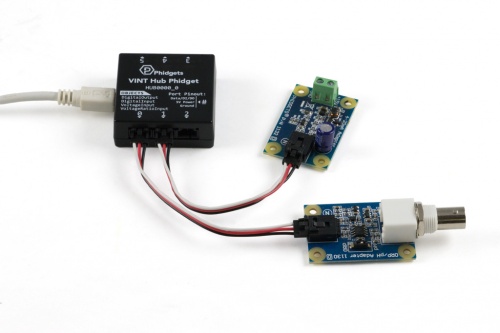Voltage Input Guide
Introduction
Voltage Input ports are used to measure the voltage on the white wire of the Phidget Cable. It is common for a sensor to output a voltage in order to relay information about what it is measuring. For example, the 1130 pH adapter and the 1132 4-20mA adapter have the following characteristics:

Sensor Voltage (V) |
1130_0 Measured pH |
1132_0 Measured Current (mA) |
| 0.25 | 1.67 | 4.44 |
| 2.5 | 7.01 | 11.11 |
| 4.75 | 12.35 | 17.78 |
This means that if you want to know the pH or current (or pressure, humidity, position, etc.), you will need to measure the sensor's output voltage. In order to do this, you can use any of our Phidgets with an analog input.
Each Phidget with an analog input interfaces with sensors using three wires:
- Power (+5 VDC) - provides the sensor with power.
- Ground
- Data - The sensor manipulates the voltage on this line. The Phidget measures and reports this voltage.
Technical Details
Factors that can affect Accuracy
- High Output Impedance - Sensors that have a high output impedance will be distorted by the input impedance of the analog input.
If your output impedance is high, it is possible to correct for this distortion to some extent in your software application.
- Voltage Drop - Phidget cables have some resistance, which can cause voltage to drop across particularly long lengths of cable, which can affect accuracy. Long cables also potentially expose the line to a greater amount of interference from surrounding electronics.
- Intrinsic Error In Sensors - For many sensors, the error is quite predictable by testing it alongside a more accurate sensor, and can be calibrated out in software.
- Voltage Reference - Voltage Reference error. The 5.0VDC voltage reference is accurate to 0.5%.
This can be a significant source of error in some applications, but can be easily measured and compensated for.
Ground Protection
Ground terminals on the VINT Hub share a common ground with USB ground. Because they are not internally isolated, these terminals will expose the USB ground potential of the PC to which they are connected. Be sure you are completely familiar with any circuit you intend to connect to the VINT port before it is connected. If a reverse voltage or dangerously high voltage is applied to the input or output terminals, damage to the Phidget or the PC may result.
By using the channel as a VoltageInput, the voltage on the line is measured independently of the USB 5V. For a sensor that outputs a voltage ratio, look at the Voltage Ratio Input Guide

